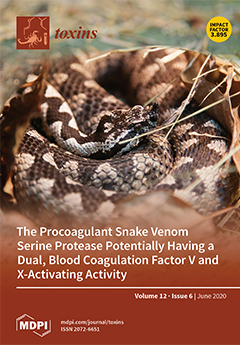The biological activity of
Rhinella icterica parotoid secretion (RIPS) and some of its chromatographic fractions (RI18, RI19, RI23, and RI24) was evaluated in the current study. Mass spectrometry of these fractions indicated the presence of sarmentogenin, argentinogenin, (5
β,12
β)-12,14-dihydroxy-11-oxobufa-3,20,22-trienolide, marinobufagin,
[...] Read more.
The biological activity of
Rhinella icterica parotoid secretion (RIPS) and some of its chromatographic fractions (RI18, RI19, RI23, and RI24) was evaluated in the current study. Mass spectrometry of these fractions indicated the presence of sarmentogenin, argentinogenin, (5
β,12
β)-12,14-dihydroxy-11-oxobufa-3,20,22-trienolide, marinobufagin, bufogenin B, 11α,19-dihydroxy-telocinobufagin, bufotalin, monohydroxylbufotalin, 19-oxo-cinobufagin, 3α,12
β,25,26-tetrahydroxy-7-oxo-5
β-cholestane-26-
O-sulfate, and cinobufagin-3-hemisuberate that were identified as alkaloid and steroid compounds, in addition to marinoic acid and
N-methyl-5-hydroxy-tryptamine. In chick brain slices, all fractions caused a slight decrease in cell viability, as also seen with the highest concentration of RIPS tested. In chick
biventer cervicis neuromuscular preparations, RIPS and all four fractions significantly inhibited junctional acetylcholinesterase (AChE) activity. In this preparation, only fraction RI23 completely mimicked the pharmacological profile of RIPS, which included a transient facilitation in the amplitude of muscle twitches followed by progressive and complete neuromuscular blockade. Mass spectrometric analysis showed that RI23 consisted predominantly of bufogenins, a class of steroidal compounds known for their cardiotonic activity mediated by a digoxin- or ouabain-like action and the blockade of voltage-dependent L-type calcium channels. These findings indicate that the pharmacological activities of RI23 (and RIPS) are probably mediated by: (1) inhibition of AChE activity that increases the junctional content of Ach; (2) inhibition of neuronal Na
+/K
+-ATPase, leading to facilitation followed by neuromuscular blockade; and (3) blockade of voltage-dependent Ca
2+ channels, leading to stabilization of the motor endplate membrane.
Full article






